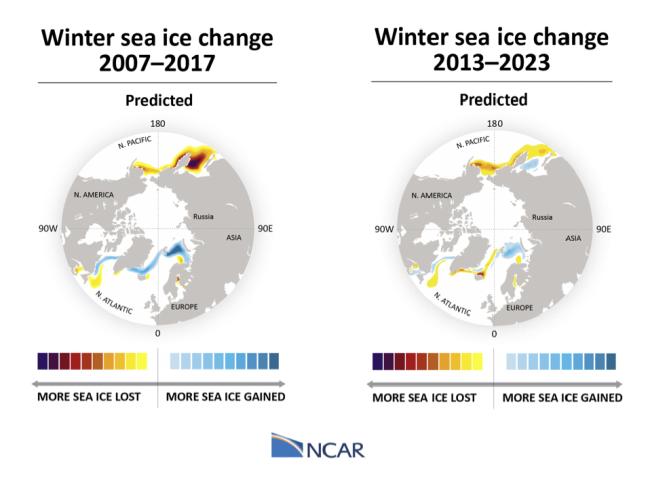Possible decadal growth in Atlantic winter sea ice extent in coming years
Climate model projections provide a compelling reason to believe that anthropogenic warming will lead to a pronounced reduction in Arctic sea ice extent over the course of this century and beyond, but there is no reason to expect this long-term sea ice retreat to occur steadily through time. Instead, natural variations in the climate system and other external forcing factors (such as volcanic eruptions) will likely cause the rate of Arctic sea ice change to vary considerably from decade to decade, and perhaps even temporarily switch from negative (sea ice loss) to positive (sea ice growth). Climate scientists at the National Center for Atmospheric Research (NCAR) present evidence in a new study that they can predict this rate, and hence anticipate whether the Arctic sea ice that forms in the winter will grow, shrink, or hold its own over decade-long time spans.

For the decade of 2007-2017 (left), the research team predicts that there may be some growth of winter sea ice in the Arctic Ocean, particularly on the Atlantic side, where scientists have the most confidence in the model's ability. The image also shows possible sea ice loss in the North Pacific. For the decade of 2013-2023 (right), the scientists expect to see some winter sea ice loss balanced with sea ice gain on the Atlantic side of the Arctic Ocean, where scientists have the most confidence in the model's ability.
The key is accurately representing the large-scale ocean circulation and associated heat transport in the climate models used to make the decadal predictions. Slow variations in upper ocean heat content that have been observed in the subpolar and marginal ice zone regions of the Atlantic since the mid-twentieth century are thought to be related to changes in the strength of the Atlantic Meridional Overturning Circulation (AMOC). Direct measurements of the AMOC are only available for the past ten years or so, but Yeager et al. present a combination of observation- and model-based evidence that suggests that the Atlantic thermohaline circulation (THC, which is closely related to AMOC) transitioned from a weak state in the 1970s to a strong state in the 1990s and that this strengthening contributed to the accelerated rate of winter sea ice loss that was observed in the late 1990s. Conversely, multiple lines of evidence suggest that the thermohaline circulation has been weakening since the start of the current century, and this weakening has occurred in tandem with an observed slow-down in the rate of Arctic winter sea ice loss, particularly in the Atlantic sector.
Ensemble decadal prediction simulations using the Community Earth System Model (CESM) can skillfully predict past decadal rates of Atlantic winter sea ice change because they do well at predicting THC-driven ocean heat content change in the vicinity of the winter sea ice edge in the Labrador, Greenland, Irminger, and Barents Seas. The most recent predictions suggest that, contrary to expected long-term trends, we should expect near neutral maintenance, or even decadal growth, of winter sea ice extent in the Atlantic sector of the Arctic in coming years.
Predicted slow-down in the rate of Atlantic sea ice loss (Geophysical Research Letters)
1National Center for Atmospheric Research
Topics
- Sea Ice
- Atlantic Ocean
- Arctic
- AMOC
